 philately
- The study or collection
of postage stamps.
philately
- The study or collection
of postage stamps.
The first stamps were issued in Great Britain in 1840 and were used to indicate that the costs of mailing had been prepaid by the sender.
One who collects stamps is a philatelist.
Used stamps are often more highly valued if they remain on their original envelope or "cover" as philatelists say.
Examples:
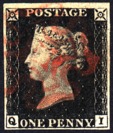
Great Britain, Penny Black, issued on May 1, 1840, engraving,
imperforate (meaning
 there
were no perforations; it had to be cut from a sheet with scissors), and canceled with
red ink, showing that it has been used. This was the world's
first postage stamp.
there
were no perforations; it had to be cut from a sheet with scissors), and canceled with
red ink, showing that it has been used. This was the world's
first postage stamp.
Here is how two Penny Blacks appeared on their cover.
The portrait of Queen Victoria in profile was designed by Henry Courbould based on a medal designed by William Wyon in 1837. The mechanically produced background was a defense against forgery. The image was engraved by the father and son team of Charles and Frederick Heath. The stamp was printed by the firm of Perkins Bacon & Petch. No stamp issued by Great Britain has ever been lettered with the country's name; all have been identifiable as British by a portrait of the reigning monarch. See English art.


American, 5-cent Benjamin Franklin and 10-cent
George Washington, 1847, engraving,
imperforate, mint (unused). These were the first postage stamps
issued by the United States of America.

Kingdom of Hawaii, 13-cent Blue, 1851, imperforate, National
Postal Museum in Washington, DC. This and other stamps among
Hawaii's first ones were nicknamed "Missionaries" after
some of the prominent occupants of the islands. Hawaii's first
postal system was established in December of 1850. The 13-cent
stamp paid both the Hawaiian and 6-cent United States postage
for letters bound to San Francisco and points east.

Vancouver Island, 12-cents Queen Victoria, 1865, engraving, printed by Thomas De La Rue
& Company, imperforate. See Canadian
art.
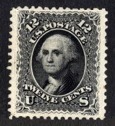
American, 12-cent George Washington, c. 1870, engraving,
perforate. This 19th century stamp pictures George Washington.
It is described as being in "mint" condition, meaning
it was never used, and is uncanceled. It has its original
gum adhesive. It is "lightly
hinged" -- it shows evidence of having been mounted in an
album with a small, folded piece of adhesive paper, as commonly
done by collectors boefore the use of transparent and acid-free
sleeves. Its condition has been assessed as "Very Fine,"
which is one of several levels on a standard scale of ratings.
Its ink is described as having "Deep
Color" -- looking fresh. There were "only 389 issued,"
and it is described as being "Very Rare
and Choice," indicating
both that few are known to have been produced (few exist) and
its excellent appearance. The 2003 Scott Catalog number 107.
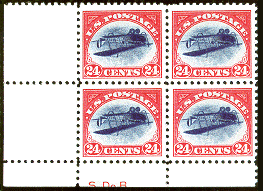
American, 24-cent "Inverted Jenny",
1918, engraving.
This is one of the most famous and highly valued of American
stamps, largely because of its rarity
as a misprint -- the biplane at its center is inverted.
The ones pictured here are all the more valuable because they
are a "block of four." A typical way of identifying
a stamp is by referring to its catalogue number. For American
stamps, the most highly regarded is the Scott Catalogue. This
rare stamp is Scott Catalogue number C3a, offered by Columbia Stamp Company.
Dubai, Six stamps commemorating 60 years of postal service, 1969.
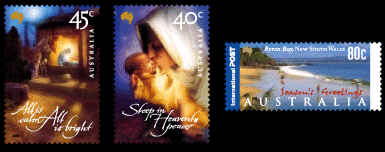
Australia, Christmas, 2000, 45 cents,
40 cents, and 80 cents, 2000.
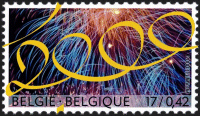
Belgium, The Year 2000, 17 francs.
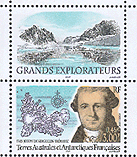
French Antarctic Territories, Great French
Explorers, 3 francs, 2000.
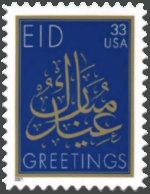
United States of America, designed by calligrapher
Mohamed Zakariya, Eid Mubarak, 33 cents, 2000, commemorates
the two most important festivals or eids in the Islamic calendar.
Eid al-Adha marks the end of the hajj, the annual period designated
for Muslims to make their pilgrimage to Mecca. Eid al-Fitr celebrates
the end of the Ramadan fast. The Arabic phrase "Eid mubarak"
translates into English as "blessed festival," and
can be paraphrased, "May your religious holiday be blessed."
See calligraphy
and Islamic
art.

Poland, Seventh Visit of Pope John Paul
II to Poland, 1.80 zloty, 2002.
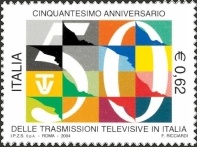
Italy, 50th Anniversary of Television
Transmission in Italy, 0.62 euro, 2004.

Ireland (Eire), Centenary Bloomsday: Ulysses
by James Joyce, 0.65 euro, 16 June, 2004.
Also see deltiologist, engraving, ephemera, exonumia, numismatics, paper, philluminist, polypropylene, printing, and scripophily.
https://inform.quest/_art